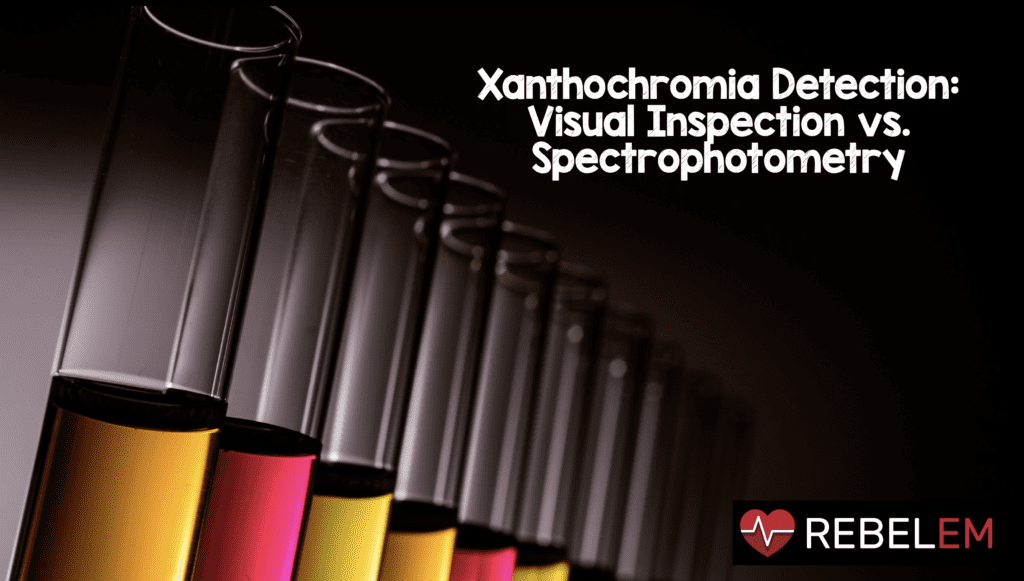
In patients with SAH diagnosed by NCHCT or suspected based on LP results, angiography (CTA or MRA) is typically performed to investigate for an aneurysm that requires neurosurgical intervention. Angiography is considered to be the “gold standard” test for looking for aneurysmal SAH although it is not without it’s own limitations (a small minority of the population will have benign aneurysms and these increase with age).
Clinical Question: What are the test performance characteristics of visual inspection and spectrophotometric assessment and how do they compare?
Article:
Chu K et al. Spectrophotometry or visual inspection to most reliably detect xanthochromia in subarachnoid hemorrhage: systematic review. Ann Emerg Med 2015. PMID: 24635988
Population: English language studies including patients presenting with headache who had LPs and CSF was evaluated for xanthochromia by either visual inspection or spectrophotometry.
Design: Systematic Review
Critical Findings
- Spectrophotometry
- Sensitivity: 86.5% (I2 = 26.1%)
- Specificity: 85.8% (I2 = 95.5%)
- (+) LR: 6.6
- (-) LR: 0.29
- Visual Inspection
- Sensitivity: 83.3% (I2 = 51.9%)
- Specificity: 95.7% (I2 = 76.0%)
- (+) LR: 14.1
- (-) LR: 0.35
In the included studies, the criteria standard for the diagnosis of aneurysmal SAH was angiography (either CTA or MRA) or clinical follow-up.
Strengths:
- First systematic review investigating this question
- QUADAS-2 tool used to assess methodological quality of included studies
Limitations:
- Only Medline, Embase and Cochrane libraries were searched for relevant articles
- Non-English studies were not included
- Grey literature search was not performed
- Only three of the studies found directly compared spectrophotometry and visual inspection
- Included studies used various outcomes to define subarachnoid hemorrhage
- Moderate to high heterogeneity between included studies prohibiting meta-analysis of the results
- The “criteria standard” for diagnosis was angiography or follow-up if angiography wasn’t performed. All patients did not receive angiography.
Authors Conclusions: “The heterogeneity in the underlying studies, combined with significant overlap in pooled confidence limits, makes it impossible to provide a definite conclusion about the diagnostic accuracy of spectrophotometry versus visual inspection.”
Our Conclusions: This systematic review highlights the nuances in the workup of SAH. The existing data on this topic demonstrates that neither spectrophotometry nor visual inspection is optimal diagnostic methods for detecting SAH in patients with normal NCHCT. It is unclear from the available evidence which method is superior.
Potential to Impact Current Practice: Based on the available literature, there is not convincing evidence to embrace one of these diagnostic tests over the other.
Bottom Line: In patients who are NCHCT negative for SAH, neither spectrophotmetry nor visual inspection for xanthochromia are perfect tests. The absence of an established “gold-standard” CSF assay limits the utility of lumbar puncture after negative NCHCT in these patients due to the issues with result interpretation.
Post Peer Reviewed By: Salim Rezaie (Twitter: @srrezaie)



